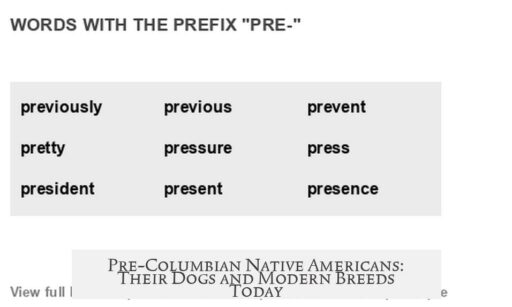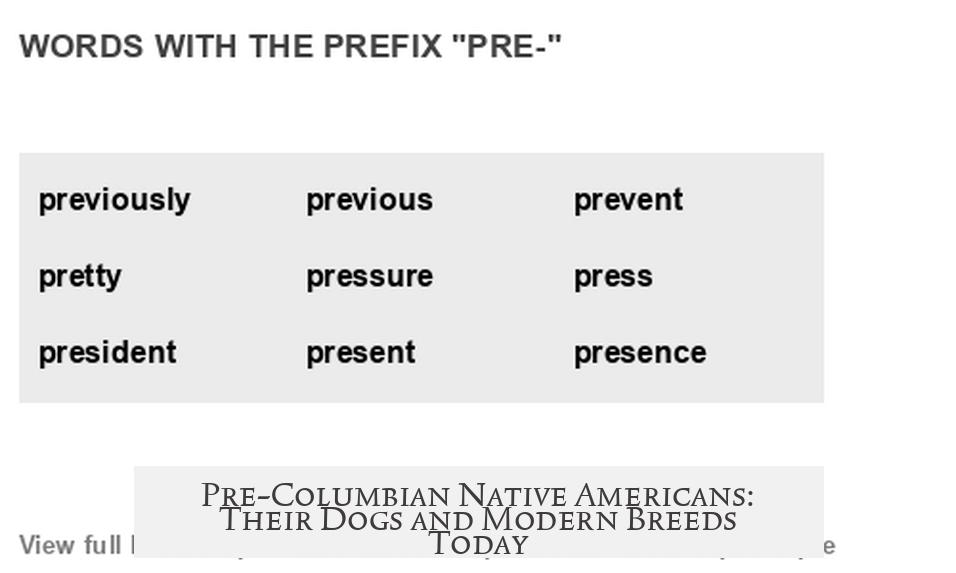Pre-Columbian Native Americans did have dogs. These dogs varied in type and function, and some breeds known today trace their roots back to those indigenous canines.

One distinct breed developed by the Coast Salish people in southwestern British Columbia is the Salish Wool Dog. This dog was unique, bred primarily for its woolly coat rather than for hunting or guarding. The indigenous people valued its hair for weaving blankets and textiles. Sources describe the Salish Wool Dog as possibly the only true breed developed by indigenous North Americans, although detailed evidence is limited. This specialized breed demonstrates a clear example of human-directed selective breeding among pre-Columbian groups.
In the Arctic and subarctic regions, the Alaskan Malamute is another example. It descends from dogs that migrated with the first humans crossing the Bering Land Bridge from Siberia into North America around 4,000 years ago. These dogs belonged to the Mahlemut (or Kobuk) people in western Alaska. The Malamute belongs to the Spitz group, known for their thick coats and endurance in cold climates.

The Malamute breed today reflects some changes since early times. In the late 1800s Gold Rush era, many sled dogs died from disease or mixed with newly introduced European breeds, such as St. Bernards and Mastiffs. This crossbreeding led to variations referred to as “Giant Malamutes” and the “MacKenzie River Malamute,” dogs bred larger and stronger for freight hauling. Despite these changes, efforts continue to preserve the original lineage and traits.
Other indigenous northern dogs include the Canadian Eskimo Dog and the Inuit Sled Dog. Both are distinct breeds with long histories as working dogs supporting survival in Arctic environments.

Further south, in Central and South America, the Xoloitzcuintle (Mexican Hairless Dog) has origins dating back over 3,000 years. This breed served spiritual and companion roles and is one of the few indigenous breeds in that region with a direct lineage traceable to pre-Columbian times.
The Chihuahua, while commonly associated with Mexico, is more difficult to trace definitively to pre-Columbian breeding. However, many experts agree it has indigenous roots, reflecting the long presence of dogs in the Americas.

In the southeastern United States, the Carolina Dog represents semi-feral descendants of Native American dogs. Genetic studies show these dogs also crossed the Bering Land Bridge with migratory peoples. Their physical form resembles the pariah dog type common worldwide—a lean, hardy dog adapted to variable environments. It is possible Native Americans bred specific traits into these dogs, but without controlled breeding, they largely reverted to this natural form. Carolina Dogs provide insight into the types of canines likely present in pre-Columbian eastern North America.
| Breed | Region/Origin | Primary Use/Notable Feature |
|---|---|---|
| Salish Wool Dog | Southwestern British Columbia | Bred for wool; used in weaving blankets |
| Alaskan Malamute | Alaska/Arctic | Sledding, freight hauling; endurance in snow |
| Canadian Eskimo Dog | Arctic Canada | Sledding and working dog |
| Xoloitzcuintle | Central and South America | Companion and spiritual dog; hairless breed |
| Chihuahua | Mexico | Small companion breed; indigenous roots uncertain |
| Carolina Dog | Southeastern United States | Semi-feral; descendants of Native American dogs |
Pre-Columbian Native Americans maintained dogs for various purposes including companionship, transportation, hunting, and resource use such as wool production. Some breeds like the Salish Wool Dog display unique human-influenced traits, while others like the Malamute illustrate the important role dogs played in cold environments.

- Dogs were present across North, Central, and South America before Columbus.
- Some breeds developed distinct traits like the Salish Wool Dog’s coat.
- Arctic breeds such as the Alaskan Malamute trace back to early migrations from Asia.
- Introduced European breeds altered native dog populations after the 1800s.
- The Carolina Dog is a living example of indigenous dog lineage in the southeastern U.S.
- Preservation efforts continue for ancient breeds like the Canadian Eskimo Dog and Xoloitzcuintle.
Did Pre-Columbian Native Americans Have Dogs? If So, What Breeds Are They Known As Today?
Yes, pre-Columbian Native Americans did have dogs, and several of their descendants are recognized today—some as formal breeds and others more informally linked through history and genetics. But this fascinating story stretches well beyond a simple “yes” or “no.” Dogs were deeply woven into Indigenous cultures, lifestyles, and survival strategies across North America long before Columbus set sail. Let’s take a stroll through time and meet some of these canine ancestors and their modern-day relatives.
Ever wondered what kind of dogs Native Americans had before European contact? You might be surprised how diverse and specialized those breeds were. Let’s start with the cozy, wooly dog that’s pretty unique in dog history.
The Salish Wool Dog: A Blanket Weaver’s Best Friend
In the cool, misty Pacific Northwest, the Coast Salish peoples didn’t just have dogs—they had the dog. Known as the Salish Wool Dog, this breed stands out for one very practical and unusual reason: its hair was used to weave blankets.
Imagine a dog living a dual life—part companion, part fiber factory. The Salish Wool Dog’s long, soft coat was highly prized and spun into warmth-giving blankets. This breed is often noted as possibly the only true dog breed developed by Indigenous North Americans specifically for its coat, according to the Wikipedia article on the subject. However, historical accounts and expert sources are limited, making it a kind of legendary figure in pre-Columbian canine history.
Salish Wool Dogs were small, compact, and covered in thick, warm fur. Their role went beyond companionship—they were integral to weaving traditions.
There are some great resources hosted by Simon Fraser University in Vancouver that delve into this breed’s cultural and material significance. Sadly, the Salish Wool Dog is extinct now, but its legacy threads through the art and stories of the Coast Salish peoples.
Alaskan Malamute: The Arctic Workhorse from the Land Bridge Era
For those fascinated by the grand, wolf-like dogs of the snowy North, the Alaskan Malamute holds a special place in history. This breed traces back thousands of years, accompanying nomadic hunters across the Bering Land Bridge from Siberia to North America.
It’s wild to think that early humans trekking from Mongolia to Alaska brought domesticated wolf-dogs with them, forming the ancestors of the Malamute. These dogs belonged to the Mahlemut tribe (now called Kuuvangmiut), part of the Inupiat people residing in upper western Alaska.
Alaskan Malamutes are part of the Spitz family, a group that includes breeds characterized by thick fur and erect ears, optimized for cold climates. Their role? Hauling heavy loads, hunting, and surviving harsh winters. They remain one of the oldest dog breeds still alive today, dating back 2,000 to 3,000 years.
Shifting Tides: How Gold Rush History Tweaked the Malamute’s Lineage
But don’t think this furry powerhouse stayed unchanged. When gold fever hit Alaska in the late 1800s, it threw the native sled dogs into a genetic free-for-all. Miners needed strong dogs to pull freight and mail through winter snows. To beef up the canine workforce, large breeds like St. Bernards and Mastiffs were imported from the continental U.S.
The unintended consequences? Native sled dogs caught diseases from these newcomers and suffered crossbreeding, leading to genetic dilution. This muddled the pure genetic line of the original Malamutes. That explains why today’s Alaskan Malamutes are not 100% genetically identical to their ancient ancestors, despite attempts by the American Kennel Club to restore their original look based on old photos and descriptions.
The so-called Giant Malamutes—some weighing over 150 lbs—are a product of this crossbreeding frenzy. Not officially recognized as a separate breed, they reflect how human needs and history shaped dog breeds in unexpected ways. Similarly, the MacKenzie River Malamute, not formally recognized either, descends from this Gold Rush era mixing and still serves as a capable sled dog.
Other Native Breeds Holding On: Canadian Eskimo Dog and Inuit Sled Dog
Away from mainland Alaska, efforts continue to preserve other indigenous arctic breeds like the Canadian Eskimo Dog and the Inuit Sled Dog. These dogs, remarkable in their endurance and adaptation to severe climates, offer living links to Native American history in the far north.
Central and South American Heritage: Xoloitzcuintle and Chihuahua
Southward, Native Americans also had distinct breeds. One remarkable example is the Xoloitzcuintle, or Mexican Hairless Dog, roaming Central and South America for at least 3,000 years. This hairless breed was not only a companion but often considered spiritual or mystical in Indigenous cultures.
Another famous breed with roots possibly pre-dating Columbus is the Chihuahua. While harder to trace, genetic and archaeological evidence link these tiny dogs to Indigenous peoples of Mexico.
Carolina Dog: Living Remnant of Ancient American Dogs
In the southeastern U.S., the Carolina Dog offers a fascinating glimpse into the past. These yellowish, semi-feral dogs roam forests and kennels alike and are thought to be descendants of the original Native American dogs that crossed from Asia during ancient migrations.
What’s cool? Their physical form resembles the pariah dogs seen worldwide—wild dogs that have natural survival traits. The Carolina Dog likely reverted to a natural form after Indigenous selective breeding ended, although some think those early humans periodically adopted the best free-roaming dogs.
Interestingly, in Southern U.S. pop culture, the “yellow dog” term often denotes the Carolina Dog, linking back to both regional jokes and proud Native American heritage.
Wrapping Up: Dogs and Native Cultures Before Columbus
So, what’s the big takeaway? Native Americans definitely had dogs before Columbus arrived, and many breeds trace their lineage back for thousands of years. Some, like the Salish Wool Dog, were specialized for cultural needs, while others, such as the Alaskan Malamute and Carolina Dog, were essential working partners and hunters.
While European contact altered many of these lineages—through disease, crossbreeding, and displacement—the legacy remains alive. Modern breeds like the Alaskan Malamute, Canadian Eskimo Dog, Xoloitzcuintle, and Carolina Dog provide tangible links to the dogs that once ran beside pre-Columbian Native Americans across forests, tundras, and plains.
Next time you see an Alaskan Malamute hauling freight or spot a Carolina Dog rooting around the woods, remember: these dogs carry stories much older than most modern breeds. They remind us that Native Americans didn’t just settle the Americas—they also shaped some of the continent’s first canine companions.
“Dogs were not just pets but an integral part of Native American survival, culture, and even textile art.”
Curious what your dog might be connected to in pre-Columbian times? Dive into breed histories and you might just uncover a wild tale of ancient migrations, cultural artistry, and survival in diverse landscapes. Isn’t history wild—in more ways than one?
Did pre-Columbian Native Americans have dogs?
Yes, pre-Columbian Native Americans had dogs. These dogs were an important part of their cultures and daily life.
What breed is the Salish Wool Dog, and what was its use?
The Salish Wool Dog was bred by the Coast Salish peoples. Its hair was used for weaving blankets, making it a unique indigenous dog breed.
Are Alaskan Malamutes native to pre-Columbian North America?
Yes, Alaskan Malamutes descend from dogs brought across the Bering Land Bridge. They are linked to the Mahlemuits tribe and have roots over 2,000 years old.
How did the Gold Rush affect Alaskan Malamute breeds?
The Gold Rush introduced new large dog breeds like St. Bernards to Alaska. Crossbreeding caused some native sled dogs to lose pure genetic lines.
Which dog breeds today trace back to indigenous North American dogs?
Breeds like the Salish Wool Dog, Alaskan Malamute, Canadian Eskimo Dog, Inuit Sled Dog, Mexican Hairless Dog (Xoloitzcuintle), Carolina Dog, and possibly Chihuahuas all trace back to Native American origins.
What is the Carolina Dog and how is it connected to Native American dogs?
The Carolina Dog is a semi-feral breed descended from Native American dogs. Its genetics confirm origins from the Bering Strait migrations and resembles early indigenous dogs.




